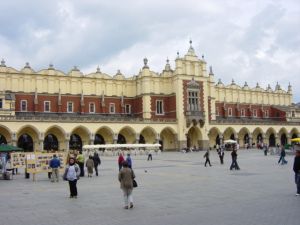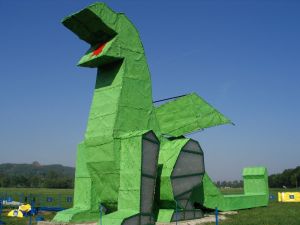|
|
 |
|
|
|
 |
| |
|
|
 |
Urban Climate
Read more |
Mitigation of air pollution
Protection of the atmosphere from the air pollution became a priority aim of the activity of many countries and international organisations, as an action contributing to the sustainable development. Many conventions and treaties were signed in order to limit the emissions of harmful substances and introduce new technologies. |
|
|
|
|
 |
|
In the 1960s and 1970s, an important change in social attitude to environmental issues took place, including the issue of air pollution. People understood that the natural environment has limits, and that its resources cannot be exploited endlessly. The industrial strategies of economic development, where the environment was treated as free resource and garbage sink, were replaced with post-industrial strategies, especially the idea of sustainable development. Its main assumption says that the economic growth should be stable, balanced, satisfy the social needs, but do not degrade the natural environment.
|
 |
 |
|
1. Mitigation of air pollution
Authors: Anita Bokwa, Pawel Jezioro
|
|
Protection of the atmosphere means limiting or eliminating the emissions of harmful substances, delivered by all sectors of economy and human activity. For particular substances, allowed concentrations in the air are defined. The pollution concentration is also named imission, and it is additionally defined for various time spans (e.g. 30 minutes, 1 day, 1 year) and places (e.g. urban areas, national parks). The imission is expressed usually in mg per m3. The word imission has also wider meaning and comprises all kinds of pollution reaching a certain area from different emittors. It means that the pollution effecting a certain area may come from many different sources, placed in that area but also far away from it, as the pollution can be brought by the wind. To obtain information about the pollution concentrations, national networks of environmental monitoring are organised. They gather, analyse and publish data concerning the state of the environment.
|
 |
 |
2. Air pollution monitoring station in a city (Cracow, Poland), belonging to the Inspectorate of Environmental Protection of the Malopolska Voivodship
photos: Sebastian Wypych |
|
 |
|
 |
 |
|
3. Recycling containers for paper, glass, metal and plstic
photo: Sebastian Wypych
|
|
 |
Many technological innovations improve the quality of the air. New combustion systems used in heating houses need less fuel (= lower combustion) to produce the same amount of energy. Other examples are: installations absorbing dust or sulphur from gases produced during the combustion, more efficient car engines, catalytic convertors. There are also other actions undertaken which aim at keeping our atmosphere clean, e.g. limitation of the usage of fuels containing sulphur, increase of usage of non-lead petrol, limitation of traffic in city centres, restructurisation of energy-consuming branches of industry, better localisation of new factories. Recycling helps to use again some materials that used to be just garbage so far.
|
 |
 |
|
4. During the First Recycling Festival in Cracow, Poland, a copy of Barbicane was built (Barbicane is the remaining of former Cracow's fortifications). The copy was made of about 36 thousand of aluminium cans, it was 7.7 m high (to the top of the towers), and had the diameter of 14 meters. It was half of the size of the original. After the festival, all the cans were delivered to the aluminium works.
photo: Sebastian Wypych
|
 |
 |
5. During the 2nd Recycling Festival in Cracow, Poland, a copy of Clothall was built. The copy was made of about 140 thousand of bottles. After the festival, all the bottles were delivered to the glass works. |
|
 |
 |
 |
photo: Sebastian Wypych |
|
 |
 |
6. During the 3rd Recycling Festival in Cracow, Poland, a copy of a hudge dragon was built. Its legs were made of about 15 thousand of bottles and its skin was covered by 650 thousand of bottles caps.
|
|
 |
 |
 |
photo: Sebastian Wypych |
|
|
In every country there are legal regulations concerning air protection, which establish the concentrations allowed in a certain country. However, air pollution can be taken by the wind from one country to another, and the construction of high chimneys (meant to protect the vicinity of the emission source from high concentrations) additionally enhances that process. Trans-boundary emissions forced international co-operation in the atmosphere protection, e.g. the actions began in 1991 by the governments of Germany, Poland and Czech Republic concerning the "Black Triangle".
|
|
An important element of the international co-operation are the conventions and treaties ratified by many countries and making an international legal system stimulating atmosphere protection, e.g. United Nations Framework Convention on greenhouse gases (more about that in: "People changing climate - More - unit 3"). The countries belonging to the European Union have common environmental policy and special funds to realize it, e.g. PHARE (Poland and Hungary Assistance in Restructuring Economiest).
|
Protection of the atmosphere demands great expenditure of money to cover the costs of introducing new technologies, follow the allowed levels of pollution concentration and organize the environmental monitoring. Therefore, various economic instruments are used to support those actions. One of them is eco-conversion, i.e. exchange of foreign debts of a country into "ecological" investments. Another instrument, raising many arguments, is emission trade, i.e. a company which emits less pollution that it is allowed to do, may sell the remaining part of the limit value to another company, which in turn may emit more pollution and not act illegaly.
7. (picture to the right) The funds from eco-conversion, PHARE etc. are used e.g. to replace traditional energy production with modern, "clean" technologies like wind turbines and solar photovolcanic systems.
Source: www.freefoto.com
|
 |
|
|
About this page:
Authors: Pawel Jezioro, Anita Bokwa - Jagiellonian University - Cracow / Poland
1. Scientific reviewer: Prof. Barbara Obrebska-Starkel - Jagiellonian University - Cracow / Poland - 2003-06-20
2. Scientific reviewer: Dr. Marek Nowosad - Maria Curie-Sklodowska University - Lublin / Poland - 2003-06-16
educational reviewing:
last update: 2004-12-17
|
|
 |
|









